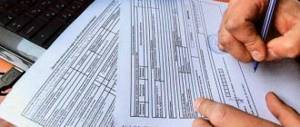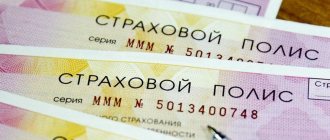Bonus-malus coefficient and its impact on the cost of compulsory motor liability insurance
Civil liability insurance for motorists operates according to a system that takes into account the interests of each party - the driver and the insurance company. To reduce their risks, the latter determine how much the compulsory motor liability insurance will increase after an accident using the client’s careful driving. Based on these indicators, special values are determined. They can affect the cost of compulsory motor liability insurance in any direction - downward or upward.
The most important indicator characterizing accident-free driving is bonus malus. The more professionally and carefully the driver drives the vehicle, the lower it is.
If the driver did not have an accident in the previous insurance period, he will be given a 5 percent discount. It is cumulative and can reach 50%. If the motorist provoked an accident, then the multiplier will increase and, as a result, compulsory motor liability insurance will become more expensive after the accident.
Thanks to KBM the following is achieved:
- Incentives are created for drivers to drive accident-free;
- The level of accuracy of all road users increases;
- Reducing the number of claims for compensation for minor damage.
Cost of OSAGO policy
The final cost of a compulsory motor liability insurance policy depends on many factors that are taken into account during registration. The most important:
- Driver's driving experience and insurance record;
- Power and type of vehicle;
- Motorist's driving history. Frequency of accidents involving the policyholder;
- Experience of other persons included in the MTPL insurance policy. No restrictions on the number of drivers.
The above factors can either reduce or increase the cost of an MTPL policy. However, many situations on the road can leave a motorist without the right to drive a vehicle. This leads to the question: “How will the cost of compulsory motor liability insurance change after the deprivation of a driver’s license?”
The cost of compulsory motor liability insurance after deprivation of a driver’s license will increase or remain unchanged
After a long-term deprivation of a driver’s license, especially if this period is longer than the validity period of a previously purchased compulsory motor liability insurance policy, the cost of new insurance may increase.
The change in the cost of compulsory motor liability insurance after deprivation of a driver's license is affected by the interruption of the insurance period, and not the fact of the violation itself (this does not mean that violations that did not lead to deprivation of the license do not increase the cost of insurance).
Violation of the continuous insurance period entails:
Dear OSAGO? Restore KBM now
and stop overpaying insurers!
The service will send an application to RSA. Recovery time for KBM: from 12 hours. Find out more
- Decrease in BMF. The bonus-malus ratio directly depends on the accuracy and conscientiousness of the policyholder. Therefore, if the driver violates the extension of the insurance period, the CBM increases, and with it the cost of compulsory motor liability insurance.
- Loss of a discount in a specific insurance company, which is given as a result of timely renewal of the MTPL contract.
Accordingly, an increase in the cost of insurance is not associated with punishment. The same increase awaits a driver who interrupted the insurance period and drove without insurance for some time. You can avoid increasing the price of compulsory motor liability insurance if you renew your policy in a timely manner.
How will the cost of compulsory motor liability insurance change for the person at fault in an accident?
The driver can independently determine how much the compulsory motor liability insurance increases after an accident, and how much it will decrease during accident-free driving. This procedure is quite simple. For calculations, insurance organizations use certain values of the increasing BMR. Its value can be found in the table:
| KBM last year | KBM in 2021 (taking into account the number of insurance payments received) | ||||
| 0 payouts | 1 payment | 2 payments | 3 payments | 4 or more payments | |
| 0,5 | 0,5 | 0,8 | 1 | 1,55 | 2,45 |
| 0,55 | 0,5 | 0,85 | 1 | 1,55 | 2,45 |
| 0,6 | 0,55 | 0,85 | 1 | 1,55 | 2,45 |
| 0,65 | 0,6 | 0,85 | 1 | 1,55 | 2,45 |
| 0,7 | 0,65 | 0,9 | 1,4 | 1,55 | 2,45 |
| 0,75 | 0,7 | 0,9 | 1,4 | 2,45 | 2,45 |
| 0,8 | 0,75 | 0,95 | 1,4 | 2,45 | 2,45 |
| 0,85 | 0,8 | 0,95 | 1,4 | 2,45 | 2,45 |
| 0,9 | 0,85 | 1 | 1,55 | 2,45 | 2,45 |
| 0,95 | 0,9 | 1,4 | 1,55 | 2,45 | 2,45 |
| 1 | 0,95 | 1,55 | 2,45 | 2,45 | 2,45 |
| 1,4 | 1 | 1,55 | 2,45 | 2,45 | 2,45 |
| 1,55 | 1,4 | 2,45 | 2,45 | 2,45 | 2,45 |
| 2,3 | 1,55 | 2,45 | 2,45 | 2,45 | 2,45 |
| 2,45 | 2,3 | 2,45 | 2,45 | 2,45 | 2,45 |
Previously, driver classes were used, there were 15 of them in total: M, 0, 1..13. Now a simple coefficient is used, which can be easily found from the table. This is the first time such a change has been made in many years. Now it is in the range from 0.5 to 2.45.
According to the new rules, the KBM for compulsory motor liability insurance after an accident changes once a year - on April 1. Thanks to this change, it is easier to check the current coefficient and update it. Whenever an insurance agreement is signed, payments for the previous year are taken into account. The RSA database contains information about the bonus-malus coefficients for each motorist. The insurance company can receive this information and use it to calculate the cost of compulsory motor liability insurance.
When you first issue a motor vehicle license, you will be assigned KBM 1. After an accident, the MTPL increasing coefficient will increase to 1.55 in the event of one accident. For two or more incidents, the multiplier will increase to 2.45. Such a sharp increase only applies to drivers with a single multiplier.
In general, the trend is that the coefficient gradually decreases for accident-free driving. However, after an accident, the cost of compulsory motor liability insurance simply soars. Then it gradually decreases again in the absence of calls to the insurance company.
Insurance coefficients for road accidents
The OSAGO coefficient is established by Article 9 of the Federal Law No. 40 of April 25, 2002 On the Automobile Citizen. A whole list of indicators falls into this category. They are divided into two main groups - fining and rewarding. The first of them includes indicators designed to hold drivers who ignore the rules accountable. They are intended to encourage compliance with traffic rules. The second group includes coefficients that simplify the purchase of insurance for persons complying with traffic rules. The coefficients included in the category are aimed at reducing the number of accidents. In 2021, there are 6 main increasing coefficients:
- Kt. The level depends on the number of accidents occurring in the region where the driver is registered. Ordinary residents of small towns pay less.
- Book Depends on compliance with the terms of the insurance contract. If they are violated, this will entail an increase in the cost of the policy.
- Kvs. Depends on the age of the driver and his driving experience. The older the citizen, the lower the cost of issuing compulsory motor insurance.
- The KBM coefficient is allocated separately. It depends on the driver's accident level.
- KN —violation coefficient.
- KM - power factor. Depends on the strength of the car engine.
How long does the increased MTPL coefficient last after an accident?
After an increase in the multiplier as a result of an accident, a motorist is usually interested in how long the increasing coefficient of compulsory motor liability insurance lasts after an accident. The value of the indicator is reviewed annually, in parallel with the purchase of the next insurance policy. The bonus-malus coefficient is not used in the following situations:
- a motor vehicle permit is issued for transit vehicles;
- the car has been registered in another state, but is temporarily registered in the Russian Federation;
- the trailer is insured;
- The insurance contract is issued for a period of less than 12 months.
What coefficients are taken into account in the calculation formula?
You can independently calculate the price of the policy using the formula:
TB x KT x PBM x KVS x KC x KP x KM x KCR x KN = MTPL price
It turns out that it's easy to calculate liability insurance manually if you know all the values. You can enter your data on our website in the calculator section for express calculation of the cost of liability, the site provides the result immediately
Below is the transcript:
- TB - basic tariff (base rate)
- CT - territorial coefficient of compulsory motor liability insurance
- Bonus malus - bonus malus coefficient
- ELC - age and length of service coefficient
- KO - limiting the number of drivers
- KS - seasonality coefficient
- CP - insurance periods
- KM - MTPL efficiency coefficient
- CRC - trailer availability
- SC - level of violations
The base tariff (rate) is calculated in rubles. The value is fixed. It is determined by the Central Bank of Russia and depends on the category of the car, the insured person (individual or legal entity), pricing policy and internal rules of the company (gender of the owner, year of manufacture of the car, etc.), purpose of the car (taxi or for personal use), color and make of the vehicle, marital status and varies within the following limits:
- (Individuals) Motorcycles: 625-1548 pp.
- Cars: 2471-5436 p.
Is it possible to avoid assigning an increasing coefficient under compulsory motor liability insurance in case of an accident?
It may seem that the owner of a car cannot avoid negative consequences if he gets into a traffic situation. This does not happen in every case. Not all traffic incidents result in an increase in the bonus-malus ratio.
One of the situations is when a driver is a victim of the actions of another driver. In such a situation, he will receive an insurance payment, and his BMI will not change. You can also avoid increasing the rate if you exclude the at-fault driver from the list of persons who have the right to drive a car for the next year. In such a situation, the insurance company will determine the need to use increasing coefficients taking into account the insurance history of those who remain on the list of trusted motorists.
In the past, car owners tried to avoid liability by changing their insurance company. They hid their participation in the accident when signing the agreement. Now such attempts do not allow success, since all information flows into a single RSA database, from which all insurers can obtain information. At the moment, the only legal method to reduce insurance costs is careful and careful behavior on the road.
How long does the boost factor last?
The increasing coefficient is valid for a year after the end of the insurance period . If a person has not contacted insurance companies during this year, then the BMR is reset to zero and becomes equal to 1. Thus, a driver who has had a long history of accident-free driving loses the accumulated discount.
If the driver did not use the vehicle for any reason, he can contact the RSA. Having drawn up a competent document, the driver can ask to return the KBM to its last value. When you subsequently contact an organization providing insurance services, the BMR must already be changed.
How to restore the KMB coefficient for compulsory motor liability insurance after an accident
If a road accident occurs, you can not only lose your existing bonuses, but also lose your KMB multiplier. As already noted, if the driver is not to blame for the incident, he is not in danger.
If you get into an accident due to inattentive driving, violating traffic rules, or being under the influence of drugs or alcohol, the KMB coefficient will be lost. Taking out the next policy will cost much more.
To restore the multiplier, you must drive the car for a long time without an accident. This can be done by contacting the insurer, the Central Bank of the Russian Federation or the Union of Auto Insurers. Some brokers also help restore the bonus-malus ratio.
The most important coefficient
Bonus Malus is one of the factors that actively influences the cost of third party insurance. However, not all drivers know what this abbreviation means. The Bonus Malus Index (BMI) is a discount that can significantly reduce the cost of your insurance. This rate is cumulative and increases with each year of continuous accident-free driving.
The only exception to the rule is if it is fully proven that the other driver was at fault for the accident, and you are completely innocent.
The maximum Bonus Malus is 2.45. And for every year of accident-free driving, the cost of your next policy will be reduced by 5%. And if you get into an accident, your next policy will cost much more. Therefore, it is better and cheaper to drive without breaking the law, keep your distance and not be distracted on the road.
But in addition to PBM, there are a number of other indicators that can change the cost of compulsory motor liability insurance:
- The region in which the vehicle is registered. In large cities and the capital, where the number of accidents is much higher, the maximum value is 2.1. In less populated regions of the country, this ratio is significantly lower.
- Age and driving experience of the person who will drive the vehicle. A driver with less than 3 years of driving experience will have to pay the most. This category is considered immature, so the number of accidents for it is higher.
- Engine power is also taken into account. Thus, engines with a power of up to 50 horsepower have a coefficient of 0.6, and engines with a power of more than 150 horsepower have a coefficient of 1.6.
- The number of violations of the contract that was concluded during the implementation of compulsory motor liability insurance. If such facts were observed more than once, then an indicator of 1.5 is used, if there were no violations, then the indicator is 1.
As you can see, PBM is one of the main indicators of rising insurance prices, but not the only one.
To calculate the cost of insurance for each individual car, we take the base rate, which is the same for everyone, and multiply it by each factor in turn. It is logical that if your rates are more than 1, then liability insurance will be much more expensive, and if less than 1, then it will be cheaper.
You can also do the calculations yourself to be prepared for the stated amount, or check the integrity of the company. To do this, simply go to the third party insurance cost calculator on our website and enter a few parameters:
- The type of car and the power of the engine installed on it. The period for which the contract will be concluded. The most common period is 1 year.
- Information about the driver: his class, experience, age.
- The region of the country in which the vehicle is registered.
How to find out the KMB coefficient for OSAGO yourself
If the driver does not want to independently calculate the bonus-malus indicator, you can simply send a corresponding request to the Union of Auto Insurers. All insured motorists have access to the database. A person can independently find the information used by an insurer’s specialist when determining the price of a car insurance policy.
To search for the KBM coefficient using the RSA database, you must perform the following steps:
- Visit the official page of the Union of Auto Insurers;
- Indicate last name, first name and patronymic, information about date of birth and VU number;
- Confirm receipt of coefficient data.
The service will independently produce all the information and provide the visitor with data on the KBM coefficient assigned at the moment.
Nuances
The law does not allow insurers to independently change the BMR. If this happens and the organization’s actions are not justified, you can send a complaint. It is submitted to law enforcement agencies. However, you need to understand when an organization’s actions are legal. In this situation, it will not be possible to change the increasing coefficient. The law allows an organization to increase the price of compulsory motor liability insurance if:
- the citizen fled the scene;
- the early person flouted the rules and drove without insurance;
- false data about the characteristics of the accident were provided;
- at the time of the accident the person was under the influence of alcohol or drugs;
- the accident was caused intentionally.
If it is proven that the citizen is not the culprit of the incident, the MSC remains at the same level. If the policy is renewed for the next year, a discount must be provided.
| Question | Answer |
| When does the MTPL increasing coefficient change in 2021? | When renewing insurance. |
| Will the MBI increase if the driver is not at fault in the accident? | No, the indicator will remain at the same level. |
| How to avoid increasing the BMR? | Follow traffic rules and try not to get into accidents. |
| What to do if the MTPL ratio was increased by mistake? | Contact the previous company and get a certificate or check the RSA database yourself. The data is then provided to the new insurer. If he refuses to change the coefficient, legal proceedings can be initiated. An alternative is to send a complaint to the authorized body. |
Comments Showing 0 of 0
How insurers can deceive clients when calculating compulsory motor liability insurance
Not only motorists strive to return the bonus-malus coefficient to its original value. Insurers also do not want to lose income and provide a discount; they are trying to find different reasons to increase the bonus-malus ratio.
The most common arguments they use to justify their actions are:
- Lack of data on changes in the driver’s documents;
- Failure of fixing equipment or system failure;
- Lack of insurance for the car owner for a year.
In an effort to reset the KBM coefficient, the insurer will explain the incident as a failure in the system. The motorist has the opportunity to return earned bonuses.
Terminology nuances
The insurance system is based on calculations of the payment rate and special parameters - coefficients.
We will talk about the value, the value of which is determined by the discipline of the driver. If the first value is established based on the assessment of the characteristics of the car and is considered a constant feature, the value of the KBM varies. Let's start by clarifying the definitions.
The abbreviation means “bonus-malus coefficient”. The value characterizes the size of the discount or additional charges for the driver of the vehicle paying for the policy.
This term is determined by the number of accidents that a motorist allows during the insurance period.
Here, the key role is played by the duration of cooperation with a certain company and the number of accidents that lead to the payment of funds to the injured party.
The system involves division into 14 classes, where each type is assigned a certain coefficient value. Accordingly, the driver falls into a specific category, which determines the size of the described constant.
After an accident, in addition to changing the value under consideration, the motorist moves into a less “reliable” category of payers. This nuance affects the calculation of the insurance amount in the next period.
A client who purchases MTPL for the first time is classified as a third class driver by default. In this case, the constant is equal to one.
How to restore the KBM coefficient when it is reset to zero
The driver should start by collecting certificates from previous insurers. Documents must confirm that the motorist has not been involved in an accident in previous periods. If the owner of the vehicle is unable to confirm the facts with documents, it will not be possible to restore the value of the coefficient.
The MTPL increasing coefficient has a strong impact on the cost of insurance services. There are now strong incentives for careful and accident-free driving. Try to avoid accidents, and you will be able to apply for compulsory motor liability insurance at a big discount.
How to get an MTPL policy after being deprived of a driver's license
If the insurance policy includes a driver who has been deprived of the right to drive a vehicle, and the insurance has restrictions, it will not be possible to renew the OSAGO policy.
The main documents required to obtain insurance are a passport, vehicle registration certificate and driver’s license. A driver who has been deprived of a driver's license does not have one. Therefore, you can extend your MTPL policy only if there are no restrictions on drivers.
When taking out a compulsory motor third party insurance policy without restrictions, the owner’s license will not be required.
Why did the price of insurance increase after an accident?
After an accident, the driver is not concerned about the issue of increasing the bonus malus. It is more important for him to understand how to properly organize the registration of an accident and how to return the money under the existing insurance.
To do this you need to follow the algorithm:
- turn on the hazard warning lights and set up a forced stop sign;
- leave the cars in their places and wait for the traffic police car;
- draw a diagram of the accident, the placement of vehicles on the roadway at the time of the incident;
- find out who is guilty and who is to blame;
- write off personal data from passports, policy number and name of the insurance company of the injured and guilty parties;
- organize a trip to the traffic police department (a certificate of an accident and a protocol of an administrative offense received there are provided to the insurance company);
- give the documentation package to the insurer;
- agree on a time to examine the vehicle for visible and invisible damage.
Expertise is everything. It is the expert who determines the price for repairing each body part, taking into account depreciation. It works using special tables.
He finds out the market value of the damaged structural elements. He performs the manipulations in such a way that the settlement amount is enough to repair and restore the car.
Help for car enthusiasts. If money is not needed, the insurer will be happy to carry out repair work through its repair shops.
The MTPL rules provide for different documentation packages depending on the circumstances of the accident.
But in each case the following documents are attached:
- Resolution on a case of an administrative offense.
- Copy of the protocol.
- Determination of refusal to initiate a case.
- Notification from the scene of an accident.
- Documents on car ownership.
- Driver's license of the participant in the accident.
- Examination documents.
- Application for payments to compensate for expenses.
Table 1. Documents for insurance payment.
| According to paragraph 51 of the Rules (loss of ability to work) | Under paragraph 53 (death of the breadwinner) |
| Doctor's report (diagnosis of time of incapacity for work) | Application listing dependents |
| About the average monthly income of the injured person on the day of injury | Birth certificates of minor children. Or a certificate from an educational institution (for children 18-23 years old) |
| Conclusion of a medical examination. | Identification of disabled dependent family members |
| Copy of death certificate |
Continuation of table 1. Documents for insurance payment.
| Under paragraph 54 (funeral expenses) | Under paragraph 55 (additional medical services) |
| Certificates of completed work, invoices from companies providing funeral services | Receipts proving payment for medications |
| Copy of death certificate | Documents from a medical institution about the cost of services provided |
| An extract from the medical history, certified by the head physician and the stamp of the organization |
Help for car enthusiasts. Funeral expenses are paid according to a tariff in an amount not exceeding 25 thousand rubles.
There are a number of coefficients officially established by insurance legislation. Depending on their size, the final cost of the policy can vary significantly.
In fact, the coefficients act as a mechanism for fining unruly drivers and rewarding those insured car owners who truly strive for safe driving.
Thus, we can distinguish the following types of motor vehicle coefficients that have one or another connection to road accidents:
- TC is a parameter focused on the territorial location of the car owner. For residents of small towns with positive statistics on the number of accidents, it is equal to 0.6 units. But motorists from large settlements with active traffic and a high accident rate will have to add a factor of 2.1 to the price of compulsory motor insurance.
- KN - depends on violations of the insurance agreement that were committed during the validity period of the contract. This, in particular, is the intentional commission of actions that caused an accident, as well as leaving the scene of an accident. Provided that the motorist strictly follows the contractual terms, the coefficient remains equal to 1. Otherwise, it increases to 1.5 units.
- PIC - the higher the age and driving experience of the driver, the less dangerous he is in terms of creating the preconditions for an accident. Therefore, for car owners under the age of 22 with up to 3 years of experience, Kvs is equal to 1.8 units. For citizens over 22 years of age with more impressive driving experience, Kvs is equal to 1.
But the most significant MTPL coefficient for road accidents, directly related to road accidents, is the bonus-malus indicator - KBM.
What does bonus-malus coefficient mean?
KBM is a variable that is directly proportional to the number of road accidents for which the policy owner is at fault. Depending on this indicator, the BMC can vary from 0.5 to 2.45 units.
Otherwise, when purchasing the next policy, you will have to pay an additional amount to the insurance company - a kind of fine for bad driving.
It is noteworthy that the coefficient is tied specifically to the driver of the car, and not to his vehicle. That is, when changing the vehicle, the driver’s class remains the same.
Video: How to get full payment from the insurance company for an accident
Currently, the presence of compulsory motor liability insurance means that the car meets technical safety standards.
For a conscientious driver, completing this paper is the only way to avoid unnecessary expenses after an accident.
True, provided that the insured person is an injured person. What to do when the policy is expired?
Some car enthusiasts solve the problem in one way. To fully cover damages, they need retroactive insurance after an accident.
In their opinion, such a document will help in two cases:
- if the driver is found guilty (CASCO policy);
- if it turns out that the policy has lost its validity period before the accident was registered.
Yes, the Internet is literally replete with offers to issue a fake document. Insurance agents, among the unscrupulous service providers, also do not refuse to help.
But when signing a policy, you need to be aware of possible further developments:
- the insurance agent and his client are declared fraudsters;
- the crime is qualified under Article 159 of the Criminal Code;
- Fines and restrictions on freedom are applied to fraudsters.
Table 3. Punishment for illegal actions under Article 159 of the Criminal Code of the Russian Federation.
| Deception, breach of trust | A crime initiated by a group of persons by prior conspiracy | Use of official position for fraudulent purposes |
| Fine up to 120 thousand rubles | Fine up to 500 thousand rubles | Fine from 100 to 500 thousand rubles |
| Imprisonment for up to two years | Imprisonment for up to five years | Imprisonment for up to six years |
Help for car enthusiasts. Fines for not having a policy are not scary. They are “issued” only when the inspector and driver are confronted and amount to no more than 800 rubles.
An accident is an extremely unpleasant fact in the history of any car owner. After this event, you should be patient and strong in order to receive insurance compensation. If the culprit escaped, you will have to go to court.
Why did the price of insurance increase after an accident?
According to the law on compulsory motor third party liability insurance, the culprit in a traffic accident bears part of the financial liability through the mechanism of applying increasing coefficients when calculating the insurance rate. The cost of the policy for the culprit will be higher.
In calculating insurance rates, 2 groups of parameters are used in accordance with Art. 9 Federal Law No. 40: the Central Bank’s base rate for compulsory motor liability insurance and coefficients that adjust the base rate. The product of the base rate and coefficients gives the calculated value of the tariff for the given conditions. Based on market conditions, insurance companies accept values that increase or decrease the cost of an insurance policy for a particular case.
After an accident, insurance increases only for the person who caused the accident. This measure is aimed at increasing the degree of liability for violators. After all, each insured event involves compensation for monetary damage to the victim for his property or compensation for damage to health.
Payments are established by law in accordance with Art. 7 Federal Law No. 40 in the amount of 500 thousand rubles for compensation for damage to health and 400 thousand rubles for damage to property.
Previously, information about road accidents was not entered by insurance companies into the general database of insurers. Today, it will not be possible to influence the coefficient, since all this data is available. How insurance changes after an accident for the culprit is usually explained by the insurance agents themselves in an individual case.
In the first year of validity of the insurance contract, the bonus-malus coefficient is 1. In this case, the car is automatically assigned class 3. With further cooperation, the changes will look like this:
- The absence of incidents and problems while driving increases the class of the car by one (4th class), while the coefficient itself is reduced to 0.95. Thus, the next insurance year will cost the car owner by as much as 5% less.
- If one incident occurs during the policy year, the compulsory motor liability insurance increases by 55% for the next year, the coefficient itself becomes equal to 1.55, and the vehicle class is downgraded to first.
- More than one incident automatically reduces the class of the car to M. In this case, the price of insurance increases by as much as 145%, which means that the bonus malus will already be 2.45, which corresponds to the maximum possible value.
It is not necessary for the car owner to make calculations independently and know how the Bonus-Malus coefficient is calculated. To do this, you can use a visual table.
The presented table of the MTPL increasing coefficient will allow you to accurately determine the size of the discount or allowance for beginners and experienced drivers. However, you should take into account another special discount, which is assigned to a client with ten years of driving experience in the absence of problems with violation of rules and traffic accidents. In this situation, it will be 50% of the possible assigned cost.
The consequences of a traffic accident can be inevitable. It is terrible if an accident ends in the death of one of the victims. It’s bad if it results in a long time to repair the vehicle.
It’s good if the insurance company pays all unforeseen expenses, and all the inconvenience will only consist of an increase in the insurance premium for the next insurance contract.
In case of one or more accidents, the price of the next contract will be higher.
After all, data about the incident is sent by the insurer to the unified OSAGO AIS database no later than 15 days.
When issuing a policy, the manager takes into account several factors:
- systematic nature of the incident;
- regularity of the event;
- whether the bonus malus was reset due to the issuance of a document with a coefficient of 1.8 (for managing an unlimited number of persons).
Let's assume that the driver has never violated traffic rules. Every year the cost of his insurance policy decreased by 5 percent. In the end, accident-free driving allows you to reduce your MTPL payment by exactly 50 percent! Huge discount!
And then one day a misfortune happened. Being recognized as the culprit of the tragedy will cost a 30 percent markup on the insurance premium.
Help for car enthusiasts. If, for example, two or more traffic accidents occur within one year due to my fault, then the insurance increases by 80 percent.
Ultimately, the maximum insurance premium reaches 25 thousand rubles.











